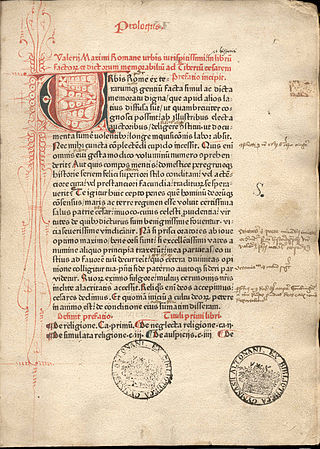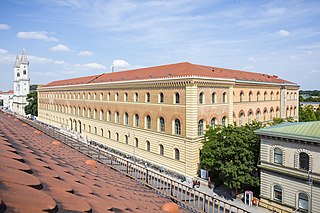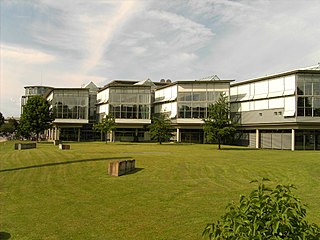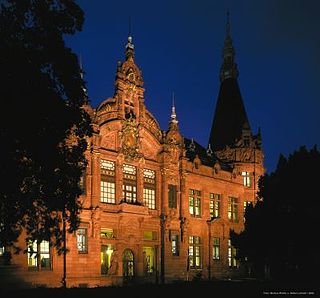Related Research Articles

An incunable or incunabulum is a book, pamphlet, or broadside that was printed in the earliest stages of printing in Europe, up to the year 1500. Incunabula were produced before the printing press became widespread on the continent and are distinct from manuscripts, which are documents written by hand. Some authorities on the history of printing include block books from the same time period as incunabula, whereas others limit the term to works printed using movable type.

The National Library of Wales, in Aberystwyth, is the national legal deposit library of Wales and is one of the Welsh Government sponsored bodies. It is the biggest library in Wales, holding over 6.5 million books and periodicals, and the largest collections of archives, portraits, maps, and photographic images in Wales. The Library is also home to the national collection of Welsh manuscripts, the National Screen and Sound Archive of Wales, and the most comprehensive collection of paintings and topographical prints in Wales. As the primary research library and archive in Wales and one of the largest research libraries in the United Kingdom, the National Library is a member of Research Libraries UK (RLUK) and the Consortium of European Research Libraries (CERL).

Moritz Steinschneider was a Moravian bibliographer and Orientalist.

The Bavarian State Library in Munich is the central "Landesbibliothek", i. e. the state library of the Free State of Bavaria, the biggest universal and research library in Germany and one of Europe's most important universal libraries. With its collections currently comprising around 10.89 million books, it ranks among the leading research libraries worldwide. The Bayerische Staatsbibliothek furthermore is Europe's second-largest journals library. Furthermore, its historical holdings encompass one of the most important manuscript collections of the world, the largest collection of incunabula worldwide, as well as numerous further important special collections. Its collection of historical prints before 1850 totals almost one million units.

The Austrian National Library is the largest library in Austria, with more than 12 million items in its various collections. The library is located in the Neue Burg Wing of the Hofburg in center of Vienna. Since 2005, some of the collections have been relocated within the Baroque structure of the Palais Mollard-Clary. Founded by the Habsburgs, the library was originally called the Imperial Court Library ; the change to the current name occurred in 1920, following the end of the Habsburg Monarchy and the proclamation of the Austrian Republic. The library complex includes four museums, as well as multiple special collections and archives.

The Göttingen State and University Library is the library for Göttingen University as well as for the Göttingen Academy of Sciences and is the state library for the German State of Lower Saxony. One of the largest German academic libraries, it has numerous national as well as international projects in librarianship and in the provision of research infrastructure services. In the year 2002, the SUB Göttingen won the German Library of the Year award. Its current director is Wolfram Horstmann.

The Répertoire International des Sources Musicales is an international non-profit organization, founded in Paris in 1952, with the aim of comprehensively documenting extant historical sources of music all over the world. It is the largest organization of its kind and the only entity operating globally to document written musical sources. RISM is one of the four bibliographic projects sponsored by the International Musicological Society and the International Association of Music Libraries, Archives and Documentation Centres, the others being Répertoire International de Littérature Musicale, Répertoire international d'iconographie musicale, and Répertoire international de la presse musicale.

The National Library of Luxembourg, abbreviated as BnL, is Luxembourg's national library. It was founded in its current form in 1899, as a result of a series of different institutions originating in the 18th century. It is located in the Kirchberg district of Luxembourg City. The BnL is a public establishment under the supervision of the Ministry of Culture.

The Heidelberg University Library is the central library of the Heidelberg University. Together with the 83 decentralized libraries of the faculties and institutes, it forms the University Library System, which is headed by the director of the University Library. The University Library holds special collections in literature concerning the Palatinate and Baden, egyptology, archeology, the history of art, and South Asia. It holds about 3.2 million books, 6,000 printed scientific periodicals, and about 500,000 other media such as microfilms and video tapes. The libraries of the faculties and institutes hold another 3 million printed books. In 2022, the University Library registered 43,600 active users who accessed more than 746,000 books. The conventional book supply is complemented by numerous electronic services, including approximately 152,00 electronic journals. The University Library provides around 1,100 reading- and workspaces in the main library in the old town and around 320 reading- and workspaces in the branch in the Neuenheimer Feld, including many IT-workstations and research stations equipped with PCs.
The Personennamendatei or PND is an authority file of people, which served primarily to access literature in libraries. The PND has been built up between 1995 and 1998 and was published by the German National Library (DNB) until 2012. For each person, there is a record with his or her name, birth and occupation connected with a unique identifier, the PND number.

Eugen Wüster was an industrialist and terminologist, regarded as "the father of technological standardization".
Bernhard Bischoff was a German historian, paleographer, and philologist; he was born in Altendorf, and he died in Munich.

The Bibliography of Music Literature is an international bibliography of literature on music. It considers all kind of music and includes both current and older literature. Since 1968, the BMS editorial staff has also been working as the German committee for the Répertoire International de Littérature Musicale (RILM). The bibliography includes monographs, master’s theses and doctoral dissertations, articles and reviews from journals, Festschriften, conference proceedings, yearbooks, anthologies, and essays from critical reports. It contains printed media as well as online resources, data media, sound recordings, audiovisual media, and microforms. Each record provides the title in the original language, full bibliographic data, a keyword index, and mostly an abstract. Currently, BMS online has more than 315,000 records of literature on music. It is supplemented by the OLC-SSG Musicology, which incorporates the contents of some more 150 music journals from 1993 onward. BMS online participates actively on Virtual Library of Musicology (ViFaMusik), the central gateway for music and musicology in Germany.

The Baden State Library is a large universal library in Karlsruhe. Together with the Württembergische Landesbibliothek, the BLB is the legal deposit and regional library for Baden-Württemberg.
Konrad Haebler was a German (Saxonian) librarian, historian and expert on incunabula.
Georg Reismüller was a German librarian. He was the Director-General of the Bavarian State Library from 1929 to 1935.

Elisabeth Niggemann is a German librarian specializing in the digitization of cultural heritage resources. From 1999 to 2019, she served as the Director General of the German National Library.

Frank Scholze is a German librarian. Since January 2020 he serves as the Director General of the German National Library.
The Association of German Librarians, also known by its German initialism VDB, represents the professional interests of academic librarians and works to promote academic books and libraries. It was founded in 1900, re-founded in 1948 (Munich) and is the oldest librarian association in Germany. The association has more than 1753 members (2020) who are employed in academic library service - or are being trained for it - or who are close to and represent the goals of the association. The office rotates with the respective board and, with the election of library director Anke Berghaus-Sprengel, has been located in Halle (Saale) at the University and State Library of Saxony-Anhalt since August 1, 2021.
References
- ↑ "About CERL". Consortium of European Research Libraries. Retrieved 6 May 2024.
- 1 2 3 4 5 6 7 Versprille, Ingeborg; Lefferts, Marian; Dondi, Cristina (2014). "The Consortium of European Research Libraries (CERL): twenty years of promoting Europe's cultural heritage in print and manuscript". Zeitschrift für Bibliothekskultur. 2 (1: Konsortien & Konsorten). University of Basel: 30–40. doi: 10.12685/027.7-2-1-50 . ISSN 2296-0597.
- ↑ "CERL's Organisation". Consortium of European Research Libraries. Retrieved 6 May 2024.
- ↑ "CERL's Organisation". Consortium of European Research Libraries. Retrieved 6 May 2024.
- ↑ "List of Members". Consortium of European Research Libraries. Retrieved 6 May 2024.
- ↑ "Heritage of the Printed Book Database (HPB)". Consortium of European Research Libraries. Retrieved 6 May 2024.
- ↑ "Material Evidence in Incunabula". Consortium of European Research Libraries. Retrieved 21 September 2016.
- ↑ "CERL Thesaurus". Consortium of European Research Libraries. Retrieved 21 September 2016.
- ↑ "CERL Portal". Consortium of European Research Libraries. Archived from the original on 1 January 2017. Retrieved 21 September 2016.
- ↑ "CERL Resources". Consortium of European Research Libraries. Retrieved 18 May 2022.
- ↑ "CERL Portal for Manuscripts and Early Printed Materials to be discontinued" (PDF). CERL Newsletter. 40: 2. December 2019.